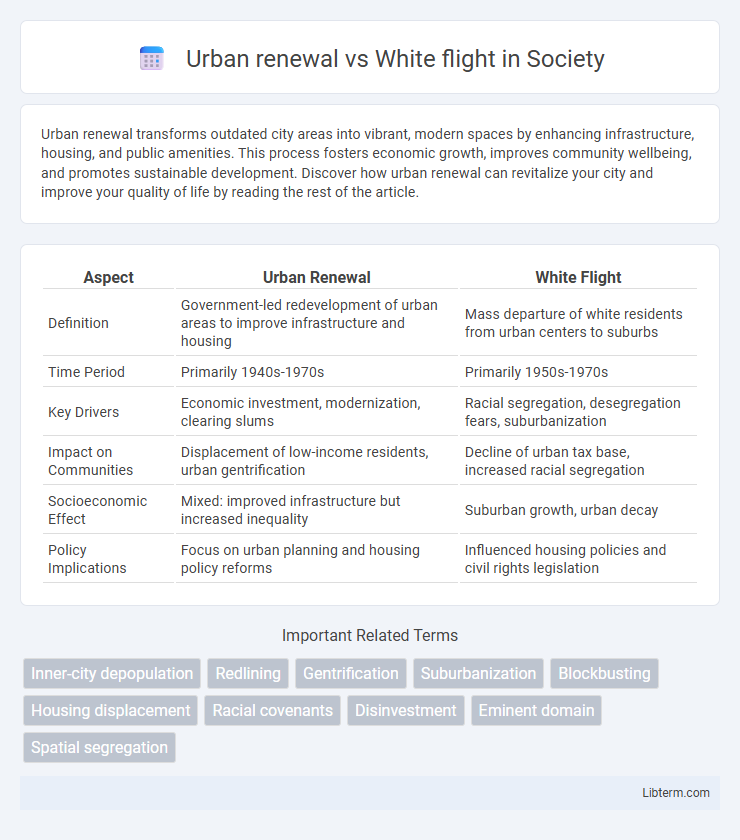Urban renewal transforms outdated city areas into vibrant, modern spaces by enhancing infrastructure, housing, and public amenities. This process fosters economic growth, improves community wellbeing, and promotes sustainable development. Discover how urban renewal can revitalize your city and improve your quality of life by reading the rest of the article.
Table of Comparison
| Aspect | Urban Renewal | White Flight |
|---|---|---|
| Definition | Government-led redevelopment of urban areas to improve infrastructure and housing | Mass departure of white residents from urban centers to suburbs |
| Time Period | Primarily 1940s-1970s | Primarily 1950s-1970s |
| Key Drivers | Economic investment, modernization, clearing slums | Racial segregation, desegregation fears, suburbanization |
| Impact on Communities | Displacement of low-income residents, urban gentrification | Decline of urban tax base, increased racial segregation |
| Socioeconomic Effect | Mixed: improved infrastructure but increased inequality | Suburban growth, urban decay |
| Policy Implications | Focus on urban planning and housing policy reforms | Influenced housing policies and civil rights legislation |
Introduction to Urban Renewal and White Flight
Urban renewal refers to the process where cities redesign and revitalize deteriorating urban areas through redevelopment projects aimed at improving infrastructure, housing, and public amenities. White flight describes the mass migration of white residents from urban centers to suburban areas, driven by racial segregation, economic shifts, and social factors during the mid-20th century. The dynamic between urban renewal and white flight significantly shaped city demographics, economic conditions, and patterns of racial segregation in American metropolitan regions.
Historical Context of Urban Renewal
Urban renewal, a mid-20th-century government policy, aimed to revitalize decaying city centers through large-scale redevelopment projects often involving demolition of low-income neighborhoods. This process disproportionately displaced African American communities, contributing to the phenomenon of white flight as white residents relocated to suburban areas seeking better living conditions. The historical context of urban renewal reveals systemic racial and economic inequalities embedded in housing policies and urban planning decisions.
The Emergence of White Flight in American Cities
The emergence of white flight in American cities during the mid-20th century was driven by suburbanization and racial segregation, as white residents moved from urban centers to suburban neighborhoods to escape increasing minority populations. Urban renewal projects, intended to revitalize decaying city areas, often displaced low-income and minority communities, exacerbating racial tensions and accelerating white flight. This demographic shift reshaped metropolitan regions, contributing to economic decline in inner cities and fostering segregated residential patterns.
Key Differences Between Urban Renewal and White Flight
Urban renewal refers to the government-led process of redeveloping and revitalizing deteriorating inner-city neighborhoods through infrastructure improvements, new housing projects, and commercial investments. White flight describes the large-scale migration of white residents from urban areas to suburban communities, often triggered by fear of declining property values and changing racial demographics. While urban renewal focuses on physical and economic transformation of cities, white flight centers on demographic shifts and social dynamics driven by racial and economic factors.
Socioeconomic Impacts on Urban Communities
Urban renewal projects often aim to revitalize decaying neighborhoods but can lead to displacement of lower-income residents, exacerbating socioeconomic inequalities. White flight intensifies economic segregation by accelerating the outmigration of wealthier, predominantly white populations, reducing the tax base and resources available for urban public services. Both phenomena contribute to concentrated poverty, diminished social mobility, and unequal access to quality education and employment opportunities in urban communities.
Racial Segregation and Demographic Shifts
Urban renewal projects in mid-20th century America often intensified racial segregation by displacing predominantly Black communities and enabling white populations to relocate to suburban areas, a phenomenon known as white flight. These demographic shifts reinforced economic disparities and spatial segregation, as investments concentrated in predominantly white neighborhoods while minority neighborhoods faced disinvestment and decline. The interplay between urban renewal policies and white flight reshaped racial landscapes, deepening segregation and altering city demographics for decades.
Policy Decisions and Government Involvement
Policy decisions during urban renewal often prioritized redevelopment projects that displaced minority communities, exacerbating social and economic inequalities. Government involvement through federally funded programs such as the Housing Act of 1949 facilitated large-scale demolitions and redevelopment while neglecting affordable housing needs, prompting many residents to relocate to suburban areas. This displacement, combined with discriminatory mortgage lending and suburban zoning laws, significantly contributed to white flight and the racial segregation of cities.
Case Studies: Urban Renewal and White Flight in Major Cities
Urban renewal projects in cities like Detroit and Chicago often aimed to revitalize decaying neighborhoods but inadvertently accelerated white flight, as predominantly white residents relocated to suburbs. Case studies reveal that large-scale demolition and displacement disproportionately affected minority communities, exacerbating racial segregation and economic inequality. These dynamics highlight the complex interaction between urban planning policies and demographic shifts in major American cities during the mid-20th century.
Long-term Effects on Housing and Infrastructure
Urban renewal often leads to significant improvements in housing quality and infrastructure by replacing dilapidated buildings with modern developments, yet it can also contribute to displacement and gentrification that alters neighborhood demographics. White flight, characterized by the migration of white residents from urban centers to suburbs, typically results in disinvestment in urban housing and infrastructure, leading to increased decay and reduced public services over time. The interplay of these phenomena frequently shapes long-term urban landscapes, influencing patterns of segregation, housing affordability, and the sustainability of infrastructure investments.
Future Perspectives on Urban Development and Integration
Urban renewal strategies prioritize sustainable infrastructure, affordable housing, and inclusive public spaces to counteract the socio-economic segregation often caused by white flight in metropolitan areas. Emerging technologies and community-driven planning emphasize equitable urban development that fosters diversity and economic resilience, promoting long-term integration. Data-driven policy frameworks aim to balance growth with social cohesion, ensuring future cities are both vibrant and inclusive.
Urban renewal Infographic

 libterm.com
libterm.com